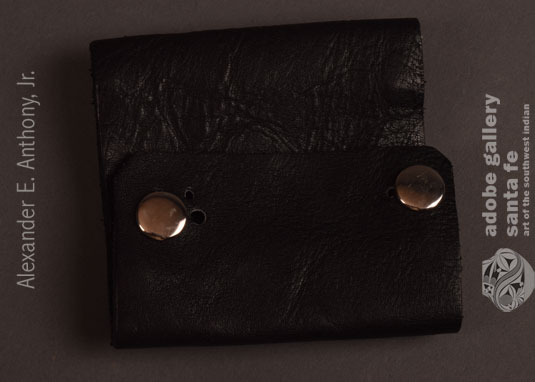Navajo Sandcast Ketoh with Geometric Design on Leather [SOLD]
+ Add to my watchlist Forward to Friend
- Category: Bracelets
- Origin: Diné of the Navajo Nation
- Medium: silver and leather, metal snaps
- Size:
3-⅞” long x 2-½” wide;
Leather strap: 4” x 9-¼” - Item # C4226 SOLD
This Navajo bowguard was made in the classic Diné sandcast technique. It has a finely crafted, narrow geometric design. Margery Bedinger writes in Indian Silver: Navajo and Pueblo Jewelers, that: “Many of the most beautiful and original ketohs are made by casting; on occasion a guard is cast in several pieces and soldered together. So much skill is required to carve a mold in an open pattern of slender elements that will withstand the pressure of hot metal, and to achieve clean-cut line, that the wrought method was used for the early bowguards and casting came only after experience had brought high craftsmanship. The typical molded ketoh is framed within bars of triangular cross section; it has a definite center.”
It is as if the maker of this ketoh read the above description given by Bedinger. Made in the 1970s, the experienced and skilled artist rendered a slender geometric pattern, one that by all accounts was very difficult to achieve. The lines are smooth and perfectly even. The final result is a classic Diné bowguard. It is set on black leather, snaps have been added creating a snug fit.
Some of the earliest articles Diné smiths made for themselves are items that never became popular for sale to outsiders. Three of these items were pouches, baldrics and ketohs or bow guards. Leather pouches were worn over the shoulder and decorated with buttons that had been hammered out from silver coins. A baldric is a leather sash worn over the shoulder, like a bandolier, decorated with conchos or stamped coins. Originally a ketoh was a plain leather bow guard, worn for practical reasons—to protect the inner wrist from the recoil of a bow string. As early as 1880 silver was added as decoration.
Today, ketohs are worn ceremonially and for special occasions by Pueblo people and Diné. Both Margery Bedinger and John Adair write about ketohs, stating they are one object that was and still is something that is made for personal use. Adair states in The Navajo and Pueblo Silversmiths that, “During the summer rain-dances in the Hopi villages and at Zuni, the dancers wear bow-guards, which are an essential part of the dress of many of the Kachina dancers.” This ketoh is unsigned.
Condition: The Navajo Sandcast Ketoh with Geometric Design on Leather is in very good condition. The silver is solid. The leather is in excellent condition.
Provenance: From a Santa Fe family. It was purchased as a gift in the 1970s.
References:
-
Indian Silver: Navajo and Pueblo Jewelers by Margery Bedinger
-
The Navajo and Pueblo Silversmiths by John Adair
Relative Links: Katsina Dolls, Southwest Indian Jewelry, Navajo Nation, Jewelry Bracelets

- Category: Bracelets
- Origin: Diné of the Navajo Nation
- Medium: silver and leather, metal snaps
- Size:
3-⅞” long x 2-½” wide;
Leather strap: 4” x 9-¼” - Item # C4226 SOLD



